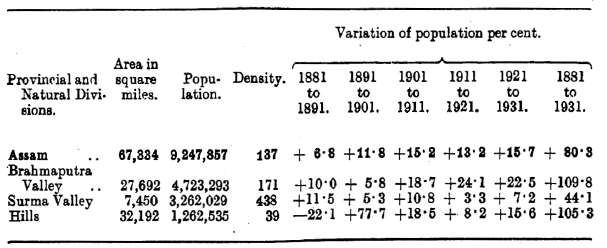Census India 1931: The Population Problem in Assam
This article is an extract from CENSUS OF INDIA, 1931 Report by J. H. HUTTON, C.I.E., D.Sc., F.A.S.B., Corresponding Member of the Anthropologische Gesselschaft of Vienna. Delhi: Manager of Publications 1933 (Hutton was the Census Commissioner for India) Indpaedia is an archive. It neither agrees nor disagrees |
The Population Problem in Assam
Assam with a present population of a nine and quarter million shows an increase since 1921 of 15.7 per cent. The decade from the point of view of public health has been " the best in the history of Assam ", and the tea industry, which is, of course, the main industry of the province beyond ordinary agriculture, was on the whole in a flourishing condition, starting the decade with a recovery from the depression of 1919-1921, booming in 1923 and 1924 and remaining prosperous until the end of 1927, when the present depression began -to be felt as a result of foreign competition and over-production. The increase in population, in spite of being the highest recorded in Assam, has been mainly due to natural increase and not to an increase by immigration which only formed ten per cent. of the total. The general economic condition of the cultivator does not seem to have deteriorated up 'to 1929 in spite of a general tendency to decay on the part of the cottage indus' "es. Up to that year the price of agricultural produce had increased and expenditure on luxuries was found by the Assam Banking Enquiry Committee to have increased like wise.
The standard of living had gone up, and so also apparently had expenditure on marriage and other ceremonies. This had involved increased indebtedness and " the average agriculturalist has not learned the importance of saving ". The increase in population has extended to the whole province, Hills and Plains districts alike, but is lowest in the Surma Valley, which is the most densely populated part and but little affected by migration. The area of the province has been slightly extended on the frontier towards Burma, but that extension of area has only accounted for 1.25 per cent. of the increase.
The area of Assam is 67,334 square miles and its population is 9,247,857,having a mean den-sit y of 137 to the square mile. This density, however, is a very variable matter.
In the Surma Valley the density is 438 per square mile, and naturally the increase in population has been least in this area. In the Brahmaputra valley it is 171, and it is in this area that immigration is most active ; in the Hills, which generally speaking afford a scanty subsistence to scattered villages, the density is only 39. There are no industrial towns in the province of any size or importance. The population is of a very mixed character.
In the Brahmaputra valley the indigenous population consists of Bodo and Shan tribes mostly Hinduised, and with an aristocracy of caste Hindus ultimately of foreign extraction but, like the small Muslim population settled in the 17th century, completely identified with the country and the people of the valley by a residence of many generations.
The recent immigrants consist either of tea garden coolies, mostly aboriginals from the Madras Agency Tracts, the Central Provinces and Chota Nagpur, who take up land and settle down in the country, and of Muslim cultivators from -Maimansingh District in Bengal who have of recent years swarmed into the lower districts of the valley and opened up large areas of waste land. Prolific breeders and industrious cultivators but unruly and uncomfortable neighbours, these immigrants threaten to swamp entirely the indigenous inhabitants and in the course of two or three decades to change the whole nature, language and religion of the Brahmaputra valley and to assimilate it to the Muslim areas of Sylhet, where the population is not Assamese but essentially Bengali, whether Muslim or Hindu. In the other district of the Surma Valley, the plains part of Cachar, the last stronghold of the Kachari kings and once completely Kachari in character, has become a Bengali colony entirely submerging the indigenous Kachari, who has retained his tribal nationality only in the North Cachar Hills.
There as in the rest of the Hill districts the indigenous tribes still hold their own, resentful of the intrusion of the plainsmen whether Bengali or Assamese and maintaining their own languages and distinctive cultures and racially belonging for the most part to Burma rather than to India.
